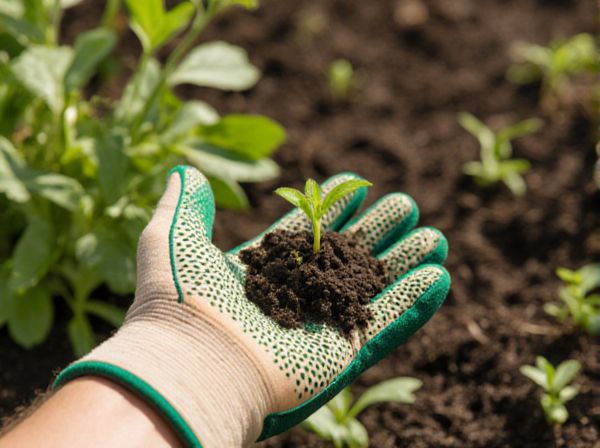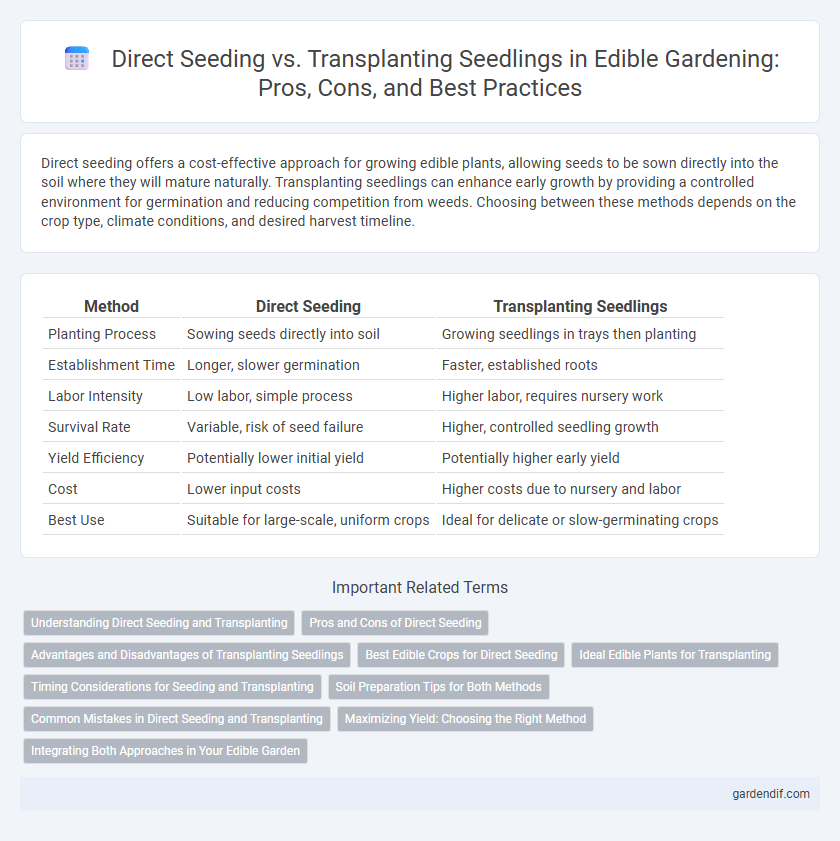
Direct seeding vs Transplanting seedlings Illustration
Direct seeding offers a cost-effective approach for growing edible plants, allowing seeds to be sown directly into the soil where they will mature naturally. Transplanting seedlings can enhance early growth by providing a controlled environment for germination and reducing competition from weeds. Choosing between these methods depends on the crop type, climate conditions, and desired harvest timeline.
Table of Comparison
| Method | Direct Seeding | Transplanting Seedlings |
|---|---|---|
| Planting Process | Sowing seeds directly into soil | Growing seedlings in trays then planting |
| Establishment Time | Longer, slower germination | Faster, established roots |
| Labor Intensity | Low labor, simple process | Higher labor, requires nursery work |
| Survival Rate | Variable, risk of seed failure | Higher, controlled seedling growth |
| Yield Efficiency | Potentially lower initial yield | Potentially higher early yield |
| Cost | Lower input costs | Higher costs due to nursery and labor |
| Best Use | Suitable for large-scale, uniform crops | Ideal for delicate or slow-germinating crops |
Understanding Direct Seeding and Transplanting
Direct seeding involves sowing edible crop seeds directly into the soil, promoting rapid root establishment and reducing initial labor costs, especially for crops like carrots and beans. Transplanting seedlings allows for controlled early growth in nurseries, enhancing plant vigor and improving yield potential for sensitive vegetables such as tomatoes and peppers. Understanding these methods helps optimize crop production by aligning planting techniques with specific crop needs and environmental conditions.
Pros and Cons of Direct Seeding
Direct seeding offers advantages such as lower initial labor costs and faster planting times compared to transplanting seedlings, making it ideal for large-scale edible crop production. However, it carries risks including uneven germination, vulnerability to pests and weather, and potential for lower early growth rates, which can impact overall crop uniformity and yield. This method suits hardy crops with reliable germination but may require more management to ensure successful plant establishment.
Advantages and Disadvantages of Transplanting Seedlings
Transplanting seedlings allows for better control over early growth conditions, leading to stronger plants and potentially higher yields. This method reduces weed competition and extends the growing season by starting plants indoors or in greenhouses. However, transplanting can be labor-intensive, increase root disturbance risk, and may cause transplant shock, which can delay plant establishment.
Best Edible Crops for Direct Seeding
Edible crops like carrots, radishes, beans, and peas thrive when direct seeded due to their delicate root systems that avoid transplant shock, resulting in faster germination and robust growth. Leafy greens such as spinach and lettuce also benefit from direct seeding, allowing for continuous harvest and minimal root disturbance. These crops, therefore, offer efficient yield and reduced labor, making direct seeding the optimal choice for home gardeners and commercial edible production.
Ideal Edible Plants for Transplanting
Leafy greens such as lettuce, kale, and spinach are ideal edible plants for transplanting due to their sensitivity to direct soil disturbances and variable germination rates. Transplanting seedlings of brassicas like broccoli, cabbage, and cauliflower enhances early growth and yield by providing a controlled environment during their vulnerable stage. Herbs like basil and parsley also benefit from transplanting, as it ensures stronger root development and reduces competition with weeds.
Timing Considerations for Seeding and Transplanting
Direct seeding enables earlier planting in the growing season as seeds can be sown immediately once soil conditions are favorable, promoting faster crop establishment. Transplanting seedlings requires starting seeds indoors 6-8 weeks before the last frost date, ensuring optimal growth before moving plants outside after the risk of frost has passed. Timing for both methods should align with crop-specific temperature and light requirements to maximize yield and reduce stress during establishment.
Soil Preparation Tips for Both Methods
For direct seeding, soil preparation requires fine, well-tilled soil free of clumps to ensure good seed-to-soil contact and consistent moisture retention. Transplanting seedlings demands enriched soil with organic matter and proper drainage to support root establishment and reduce transplant shock. Both methods benefit from soil testing to balance pH levels and nutrient content, optimizing plant growth conditions.
Common Mistakes in Direct Seeding and Transplanting
Common mistakes in direct seeding include sowing seeds too deeply, resulting in poor germination, and overcrowding, which limits air circulation and nutrient availability. Transplanting seedlings often suffers from root damage and transplant shock due to improper handling or insufficient hardening off before planting. Both methods require precise timing and soil conditions to optimize plant establishment and yield.
Maximizing Yield: Choosing the Right Method
Direct seeding often results in higher crop density and can reduce labor costs, making it ideal for large-scale edible crop production. Transplanting seedlings provides stronger initial plant development and increases survival rates, which can lead to higher yields in shorter growing seasons. Selecting the right method depends on crop type, climate conditions, and available resources to maximize edible yield efficiently.
Integrating Both Approaches in Your Edible Garden
Integrating both direct seeding and transplanting seedlings in your edible garden maximizes crop diversity and extends harvest periods. Direct seeding allows root vegetables like carrots to develop undisturbed, while transplanting supports fast-growing or heat-sensitive crops such as tomatoes and peppers. This combined approach optimizes space utilization, reduces transplant shock, and enhances overall garden productivity.
Direct seeding vs Transplanting seedlings Infographic

 gardendif.com
gardendif.com